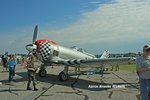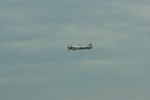Adding a turbocharger as second stage will increase performance at high altitudes almost for free (the engine is not robbed of any power to compress the air) but it adds weight and complexity. Let's be realistic. If all you have is 1200-1300HP you want your plane to be as light as possible. A two speed, single stage supercharger would be a better option, the only added weight being the additional gearbox and extra clutch needed.
Here's come another dilemma. Should you sacrifice armor protection and a certain tolerance to damage or design the lightest possible frame?
Early Mitsubishi A6Ms were incredibly light for a plane of that size (around 1600Kg empty) but also very vulnerable. Its main antagonist in the PTO, the F4F-3, was praised for its robustness but it weighted (empty) nearly 1 ton more. A sweet spot would be somewhere between these two extremes, around 1900-2000Kg (4400lbs).
My "What IF" fighter built around a P&W R-1830 would be something like this: it uses a Pratt&Whitney R-1830 with single stage, two speed supercharger; it has the fuselage of a Nakajima Ki-44 Tojo, mated to the wings of a Me-109G. Empty equipped weight would be around 2000Kg, take-off weight around 2600-2700Kg.
It would reach around 580Km/h at about 4500m (15000ft). A decent fighter by 41-42 standards but hopelessly underpowered later in the war.
Here's come another dilemma. Should you sacrifice armor protection and a certain tolerance to damage or design the lightest possible frame?
Early Mitsubishi A6Ms were incredibly light for a plane of that size (around 1600Kg empty) but also very vulnerable. Its main antagonist in the PTO, the F4F-3, was praised for its robustness but it weighted (empty) nearly 1 ton more. A sweet spot would be somewhere between these two extremes, around 1900-2000Kg (4400lbs).
My "What IF" fighter built around a P&W R-1830 would be something like this: it uses a Pratt&Whitney R-1830 with single stage, two speed supercharger; it has the fuselage of a Nakajima Ki-44 Tojo, mated to the wings of a Me-109G. Empty equipped weight would be around 2000Kg, take-off weight around 2600-2700Kg.
It would reach around 580Km/h at about 4500m (15000ft). A decent fighter by 41-42 standards but hopelessly underpowered later in the war.
Last edited:


